Studying Thermal and Mechanical Properties of Recycled Concrete by Using Ceramic Aggregate
Abstract
:1. Introduction
2. Materials and Testing Procedure
Materials, Mixture and Test Procedure
- (1)
- Materials
- (2)
- Mixture
- (3)
- Specimen and test procedure
3. Results, Analysis, and Discussion
3.1. Physical and Mechanical Properties
- (1)
- Ceramic recycled concrete
- (2)
- Hollow block of ceramic recycled concrete
3.2. Thermal Conductivity of Concrete Insulation Board
3.3. Thermal Conductivity of Concrete Hollow Blocks
- 1.
- Heat conductivity
- 2.
- Thermal inertia index
4. Conclusions
- The density and strength of ceramic recycled concrete are directly related, and both are affected by ceramic aggregate replacement ratio. Properly adjusting the amount of ceramic aggregate can meet the different requirements for concrete strength;
- For ceramic recycled concrete board, the physical property is directly related to its thermal properties: the smaller the density, the lower the thermal conductivity and higher thermal resistance. The addition of ceramic aggregate can improve the thermal insulation performance of concrete;
- For ceramic hollow blocks, the variation in thermal performance with ceramic aggregate content is similar to that of ceramic recycled concrete: with the increase in ceramic aggregate ratio, the thermal conductivity decreases and the thermal inertia index D increases. The amount of ceramic aggregate should be seriously considered to balance the relationship between mechanical properties and thermal properties;
- The use of ceramic recycled concrete as a non-load-bearing construction material can overcome its disadvantages in mechanical properties and fully reflect its functional advantages, with good environmental and economic benefits.
Author Contributions
Funding
Institutional Review Board Statement
Informed Consent Statement
Data Availability Statement
Conflicts of Interest
References
- Xiao, J. Recycled Aggregate Concrete Structures; Springer: Berlin/Heidelberg, Germany, 2018; ISBN 9783662539859. [Google Scholar]
- Rezaei, S.D.; Shannigrahi, S.; Ramakrishna, S. A review of conventional, advanced, and smart glazing technologies and materials for improving indoor environment. Sol. Energy Mater. Sol. Cells 2017, 159, 26–51. [Google Scholar] [CrossRef]
- Deba, C.; Zhang, F.; Yang, J.; Lee, S.E.; Shah, K.W. A review on time series forecasting techniques for building energy consumption. Renew. Sustain. Energy Rev. 2017, 74, 902–924. [Google Scholar] [CrossRef]
- Shen, L.Y.; Tam, V.W.; Tam, C.M.; Drew, D. Mapping approach for examining waste management on construction sites. J. Constr. Eng. Manag. 2004, 130, 472–481. [Google Scholar] [CrossRef]
- Ginga, C.P.; Ongpeng, J.M.C.; Daly, M.; Klarissa, M. Circular economy on construction and demolition waste: A literature review on material recovery and production. Materials 2020, 13, 2970. [Google Scholar] [CrossRef]
- Forward. Report of Market Research and Investment Forecast Analysis on China Construction and Demolition Waste Disposal Industry (2020–2025); Forward Business Information Co. Ltd.: Shenzhen, China, 2020. [Google Scholar]
- Prakash, R.; Raman, S.N.; Subramanian, C.; Divyah, N. 6—Eco-friendly fiber-reinforced concretes. In Handbook of Sustainable Concrete and Industrial Waste Management; Woodhead Publishing: Cambridge, UK, 2022; pp. 109–145. [Google Scholar] [CrossRef]
- Prakash, R.; Divyah, N.; Srividhya, S.; Avudaiappan, S.; Amran, M.; Raman, S.N.; Guindos, P.; Vatin, N.I.; Fediuk, R. Effect of Steel Fiber on the Strength and Flexural Characteristics of Coconut Shell Concrete Partially Blended with Fly Ash. Materials 2022, 15, 4272. [Google Scholar] [CrossRef]
- Prakash, R.; Thenmozhi, R.; Raman, S.N.; Subramanian, C. Characterization of eco-friendly steel fiber-reinforced concrete containing waste coconut shell as coarse aggregates and fly ash as partial cement replacement. Struct. Concr. 2020, 21, 437–447. [Google Scholar] [CrossRef]
- Wu, H.; Zuo, J.; Zillante, G.; Wang, J.; Yuan, H. Construction and demolition waste research: A bibliometric analysis. Archit. Sci. Rev. 2019, 62, 354–365. [Google Scholar] [CrossRef]
- Fonseca, F.L.C.; Namen, A.A. Characteristics and patterns of inappropriate disposal of construction and demolition waste in the municipality of Cabo Frio, Brazil. Urbe. Rev. Bras. Gestão Urbana 2021, 13, e20200091. [Google Scholar] [CrossRef]
- Posi, P.; Thongjapo, P.; Thamultree, N.; Boontee, P.; Kasemsiri, P.; Chindaprasirt, P. Pressed lightweight fly ash-OPC geopolymer concrete containing recycled lightweight concrete aggregate. Constr. Build. Mater. 2016, 127, 450–456. [Google Scholar] [CrossRef]
- Pham, T.M.; Elchalakani, M.; Hao, H.; Lai, J.; Ameduri, S.; Tran, T.M. Durability characteristics of lightweight rubberized concrete. Constr. Build. Mater. 2019, 224, 584–599. [Google Scholar] [CrossRef]
- Divyah, N.; Prakash, R.; Srividhya, S.; Sivakumar, A. Parametric study on lightweight concrete-encased short columns under axial compression-Comparison of design codes. Struct. Eng. Mech. 2022, 83, 387–400. [Google Scholar] [CrossRef]
- Prakash, R.; Raman, S.N.; Divyah, N.; Subramanian, C.; Vijayaprabha, C.; Praveenkumar, S. Fresh and mechanical characteristics of roselle fibre reinforced self-compacting concrete incorporating fly ash and metakaolin. Constr. Build. Mater. 2021, 290, 123209. [Google Scholar] [CrossRef]
- Xie, J.; Zhao, J.; Wang, J.; Huang, P.; Liu, J. Investigation of the high-temperature resistance of sludge ceramsite concrete with recycled fine aggregates and GGBS and its application in hollow blocks. J. Build. Eng. 2021, 34, 101954. [Google Scholar] [CrossRef]
- Zhai, X.; Yan, J.; Cao, C. Seismic performance and flexible connection optimization of prefabricated integrated short-leg shear wall filled with ceramsite concrete. Constr. Build. Mater. 2021, 311, 125224. [Google Scholar] [CrossRef]
- Shen, Y.; Huang, J.; Ma, X.; Hao, F.; Lv, J. Experimental study on the free shrinkage of lightweight polymer concrete incorporating waste rubber powder and ceramsite. Compos. Struct. 2020, 242, 112152. [Google Scholar] [CrossRef]
- Rathore, P.K.S.; Gupta, N.K.; Yadav, D.; Shu, K.; Kaul, S. Thermal performance of the building envelope integrated with phase change material for thermal energy storage: An updated review. Sustain. Cities Soc. 2022, 79, 103690. [Google Scholar] [CrossRef]
- Fan, L.D.; Zhang, Z.J.; Yu, Y.Q.; Li, P.T.; Cosgrove, T. Effect of elevated curing temperature on ceramsite concrete performance. Constr. Build. Mater. 2017, 153, 423–429. [Google Scholar] [CrossRef]
- Kim, H.K.; Jeon, J.H.; Lee, H.K. Workability, and mechanical, acoustic and thermal properties of lightweight aggregate concrete with a high volume of entrained air. Constr. Build. Mater. 2012, 29, 193–200. [Google Scholar] [CrossRef]
- Han, R.B.; Xu, Z.M.; Qing, Y.T. Study on the Material Performance of Ceramsite Concrete Roof Brick. Procedia Eng. 2017, 205, 642–649. [Google Scholar] [CrossRef]
- Jo, B.W.; Park, S.K.; Jong-bin Park, J.B. Properties of concrete made with alkali-activated fly ash lightweight aggregate (AFLA). Cem. Concr. Comp. 2006, 35, 1235–1243. [Google Scholar] [CrossRef]
- Cheeseman, C.R.; Virdi, G.S. Properties and microstructure of lightweight aggregate produced from sintered sewage sludge ash Resources. Conserv. Recycl. 2005, 45, 18–30. [Google Scholar] [CrossRef]
- Hou, Z.; Tang, J. Technical Property and Applying for Bridge Deck of Ceramsite Concrete; American Society of Civil Engineers: Reston, VA, USA, 2011; pp. 1898–1903. [Google Scholar] [CrossRef]
- Yuan, H.Q.; Jing, H.; Tang, D.Y.; Liu, W.L. Mechanical properties of shale ceramisite concrete with recycled rubber powder under compression. J. Build. Mater. 2007, 10, 369–373. [Google Scholar]
- Malaiškiene, J.; Vaiciene, M.; Zurauskien, R. Effectiveness of technogenic waste usage in products of building ceramics and expanded clay concrete. Constr. Build. Mater. 2011, 25, 3869–3877. [Google Scholar] [CrossRef]
- Liu, J.Z.; Ba, M.F.; He, Z.M.; Li, Y.S. Microstructure and performance of sludge-ceramisite concrete. Constr. Build. Mater. 2013, 39, 82–88. [Google Scholar] [CrossRef]
- Alessandro, A.; Pisello, A.L.; Fabiani, C.F. Multifunctional smart concretes with novel phase change materials: Mechanical and thermo-energy investigation. Appl. Energy 2018, 212, 1448–1461. [Google Scholar] [CrossRef]
- Ling, T.C.; Poon, C.S. Use of phase change materials for thermal energy storage in concrete: An overview. Constr. Build. Mater. 2013, 46, 55–62. [Google Scholar] [CrossRef]
- Ding, W.H.; Zhu, L.; Li, H.; Hou, B.; Yang, F. Mechanical and Thermal Properties of Shale Ceramsite Concrete: Experimental Study on the Influence Law due to Microencapsulated Phase-Change Material Content and Phase-Change Cycle Numbers. Adv. Civ. Eng. 2022, 2022, 2720956. [Google Scholar] [CrossRef]
- Xiao, J.; Li, W.; Fan, Y.; Huang, X. An overview of study on recycled aggregate concrete in China (1996–2011). Constr. Build. Mater. 2012, 31, 364–383. [Google Scholar] [CrossRef]
- Hamad, B.S.; Dawi, A.H. Sustainable normal and high strength recycled aggregate concretes using crushed tested cylinders as coarse aggregates. Case Stud. Constr. Mater. 2017, 7, 228–239. [Google Scholar] [CrossRef]
- Hansen, T.C. Recycled aggregates and recycled aggregate concrete second state-of-the-art report developments 1945–1985. Mater. Struct. 1986, 19, 201–246. [Google Scholar] [CrossRef]
- Khatib, J.M. Properties of concrete incorporating fine recycled aggregate. Cem. Concr. Res. 2005, 35, 763–769. [Google Scholar] [CrossRef]
- Braga, M.; de Brito, J.; Veiga, R. Incorporation of fine concrete aggregates in mortars. Constr. Build. Mater. 2012, 36, 960–968. [Google Scholar] [CrossRef]
- Kou, S.C.; Poon, C.S. Properties of concrete prepared with crushed fine stone, furnace bottom ash and fine recycled aggregate as fine aggregates. Constr. Build. Mater. 2009, 23, 2877–2886. [Google Scholar] [CrossRef]
- Evangelista, L.; de Brito, J. Mechanical behaviour of concrete made with fine recycled concrete aggregates. Cem. Concr. Compos. 2007, 29, 397–401. [Google Scholar] [CrossRef]
- Etxeberria, M.; Vázquez, E.; Marí, A.; Barra, M. Influence of amount of recycled coarse aggregates and production process on properties of recycled aggregate concrete. Cem. Concr. Res. 2007, 37, 735–742. [Google Scholar] [CrossRef]
- Zhao, Z.F.; Remond, S.; Damidot, D.; Xu, W.Y. Influence of fine recycled concrete aggregates on the properties of mortars. Constr. Build. Mater. 2015, 81, 179–186. [Google Scholar] [CrossRef]
- Li, Z.; Liu, J.P.; Xiao, J.Z.; Zhong, P.H. A method to determine water absorption of recycled fine aggregate in paste for design and quality control of fresh mortar. Constr. Build. Mater. 2019, 197, 30–41. [Google Scholar] [CrossRef]
- GB/T 17431.2-2010; Lightweight Aggregates and Its Test Methods—Part 2: Test Methods for Lightweight Aggregates. National Standards of the People’s Republic of China: Beijing, China, 2010.
- GB/T 14685-2011; Pebble and Crushed Stone for Construction. National Standards of the People’s Republic of China: Beijing, China, 2011.
- GB/T 25176-2010; Recycled Fine Aggregate for Concrete and Mortar. National Standards of the People’s Republic of China: Beijing, China, 2010.
- JGJ51-2002; Technical Specification for Lightweight Aggregate Concrete. Industry standard of the People’s Republic of China: Beijing, China, 2002.
- DG/TJ08-2018-2007; Technical Code on the Application of Recycled Concrete. Shanghai Engineering Construction Code: Shanghai, China, 2007.
- Sagoe-Crentsil, K.K.; Brown, T.; Taylar, A.H. Performance of concrete made with commercially produced coarse recycled concrete aggregate. Cem. Concr. Res. 2001, 31, 707–712. [Google Scholar] [CrossRef]
- Xiao, J.Z.; Liu, Q.; Du, J.T.; Zhang, C.Z. Micro-damage mechanisms and property fluctuation off recycled aggregate concrete. Key Eng. Mater. 2007, 348, 611–664. [Google Scholar] [CrossRef]
- GB/T 50081-2002; Standard for Test Method of Mechanical Properties on Ordinary Concrete. National Standards of the People’s Republic of China: Beijing, China, 2002.
- GB/T 10295-2008; Thermal Insulation-Determination of Steady-State Thermal Resistance and Related Properties—Heat Flow Meter Apparatus. National Standards of the People’s Republic of China: Beijing, China, 2008.
- GB 50176-2016; Code for Thermal Design of Civil Building. National Standards of the People’s Republic of China: Beijing, China, 2016.
- Alengaram, U.J.; Al Muhit, B.A.; bin Jumaat, M.Z.; Jing, M.L.Y. A comparison of the thermal conductivity of oil palm shell foamed concrete with conventional materials. Mater. Design 2013, 51, 522–529. [Google Scholar] [CrossRef]
- Wadsö, L.; Karlsson, J.; Tammo, K. Thermal properties of concrete with various aggregates. Engineering. 2012. Available online: http://www.byggnadsmaterial.lth.se/fileadmin/byggnadsmaterial/Research/CERBOF/Thermal_properties__nr_10_.pdf (accessed on 23 October 2022).
- Demirboğa, R. Influence of mineral admixtures on thermal conductivity and compressive strength of mortar. Energy Build. 2003, 35, 189–192. [Google Scholar] [CrossRef]
- Bouguerra, A.; Ledhem, A.; De Barquin, F.; Dheilly, R.; Queneudec, M. Effect of microstructure on the mechanical and thermal properties of lightweight concrete prepared from clay, cement, and wood aggregates. Cem. Concr. Res. 1998, 28, 1179–1190. [Google Scholar] [CrossRef]
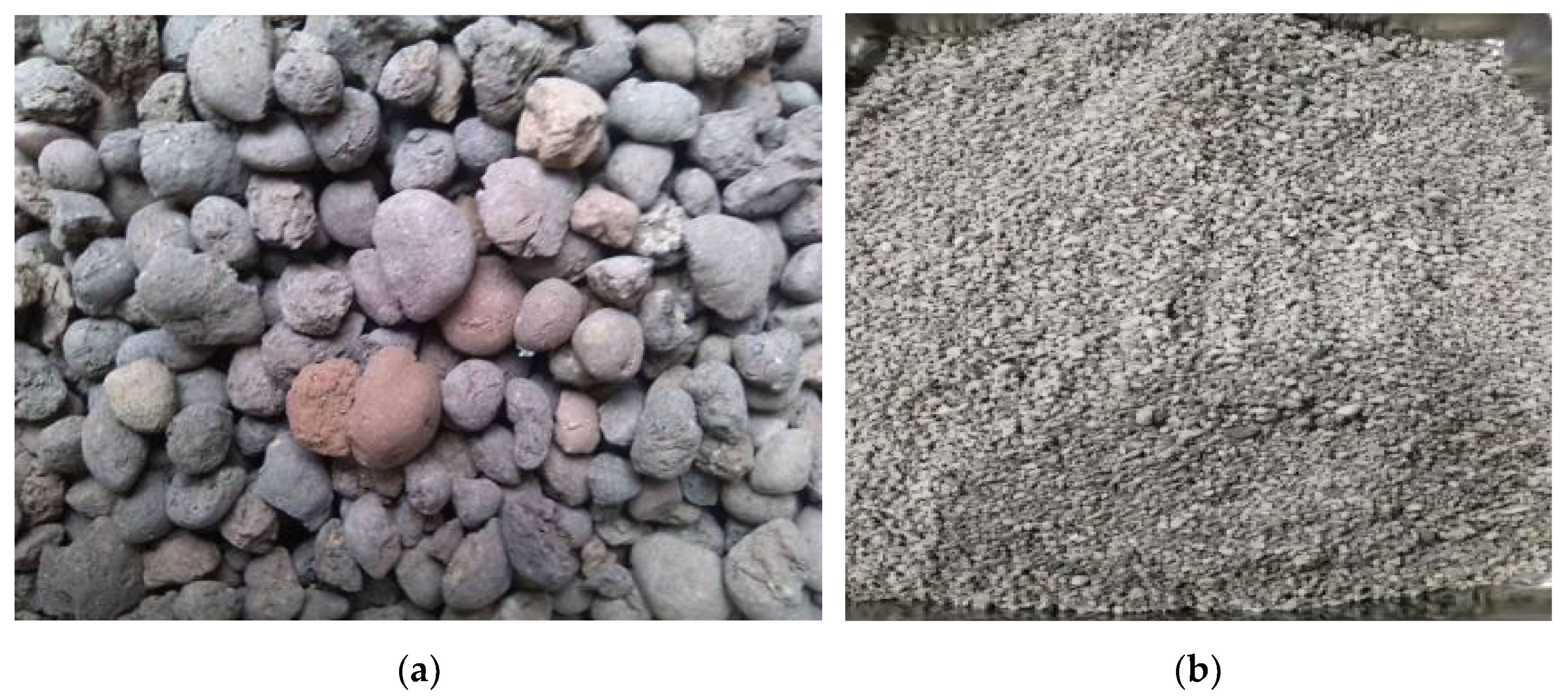

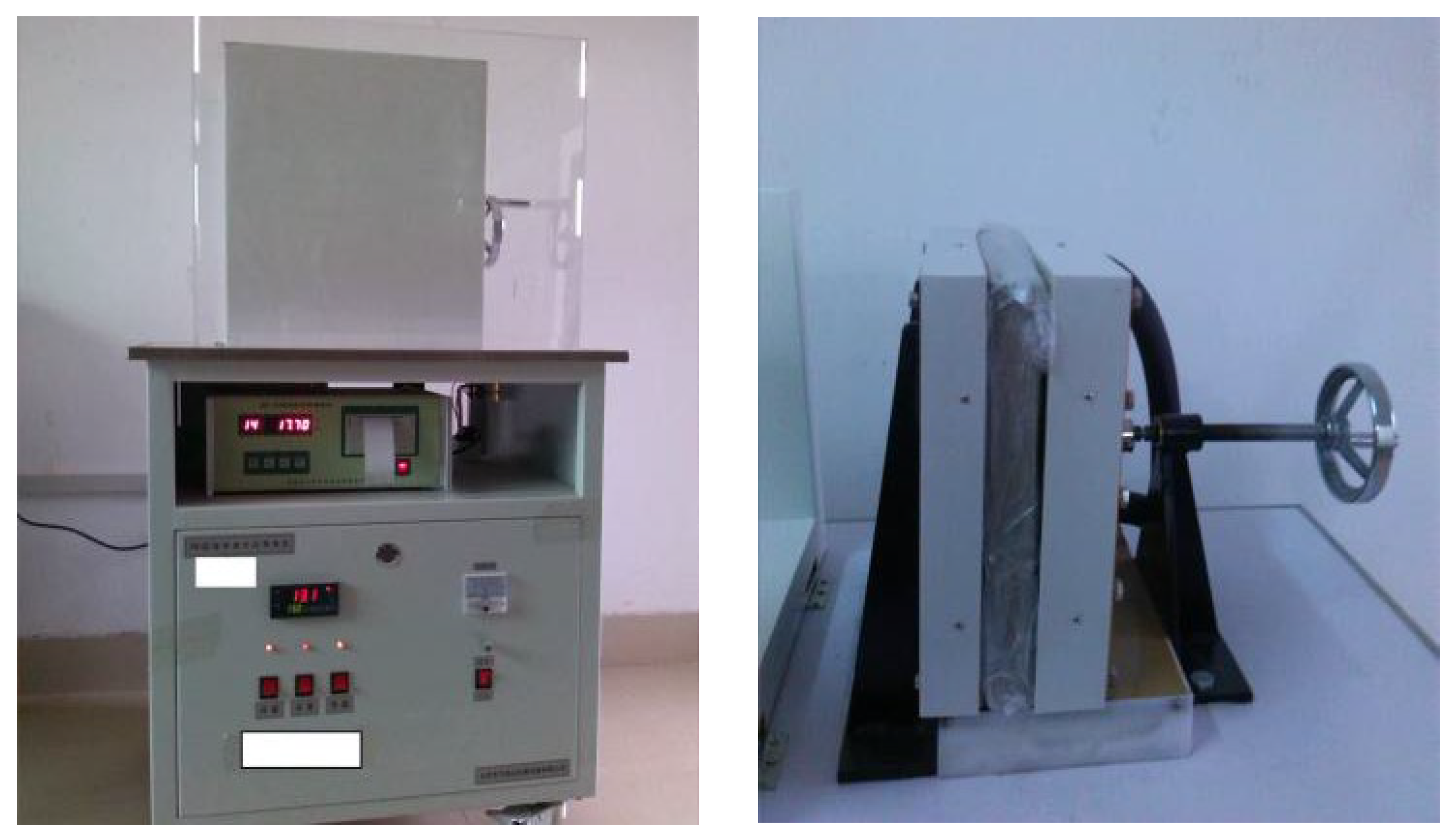

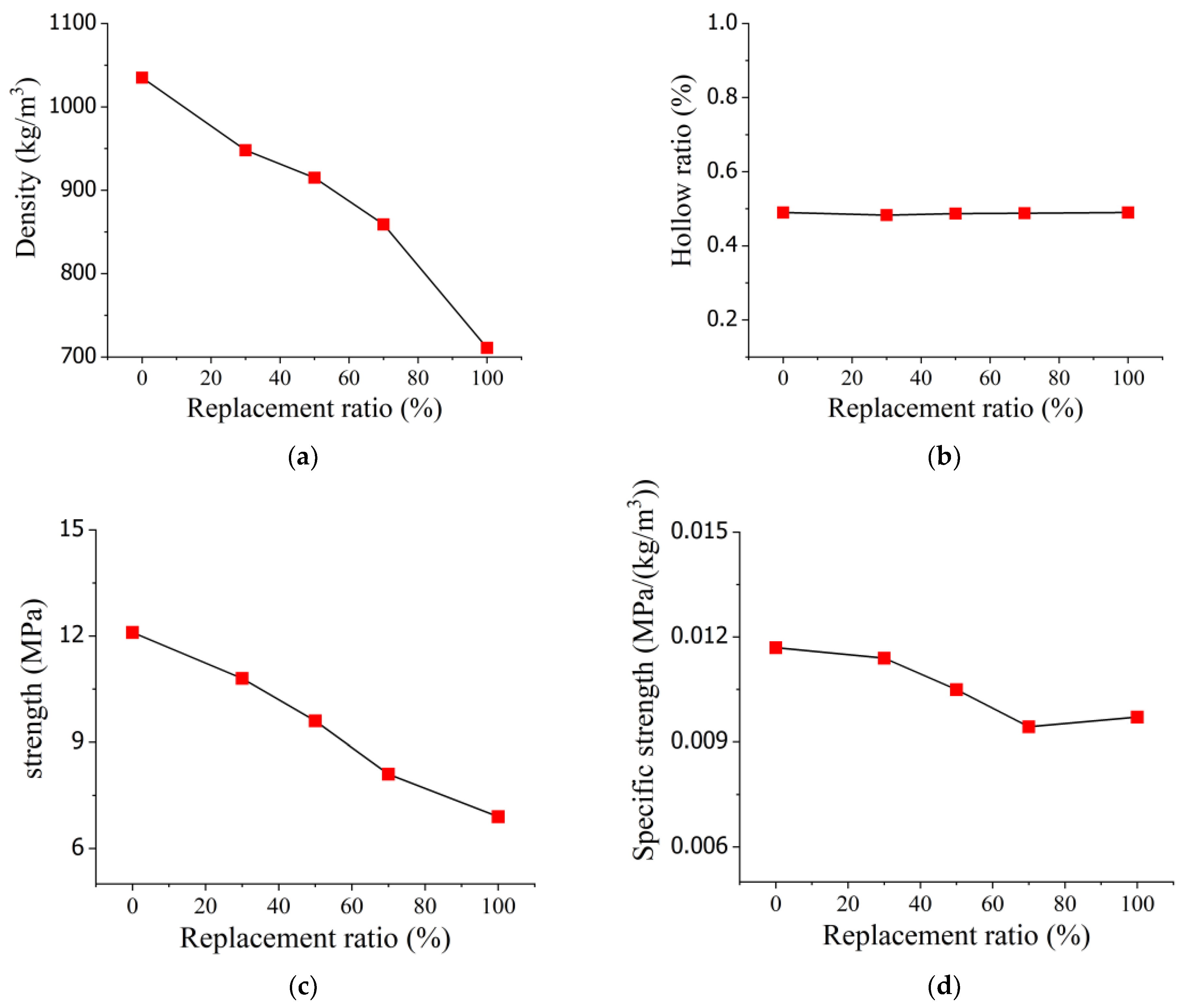

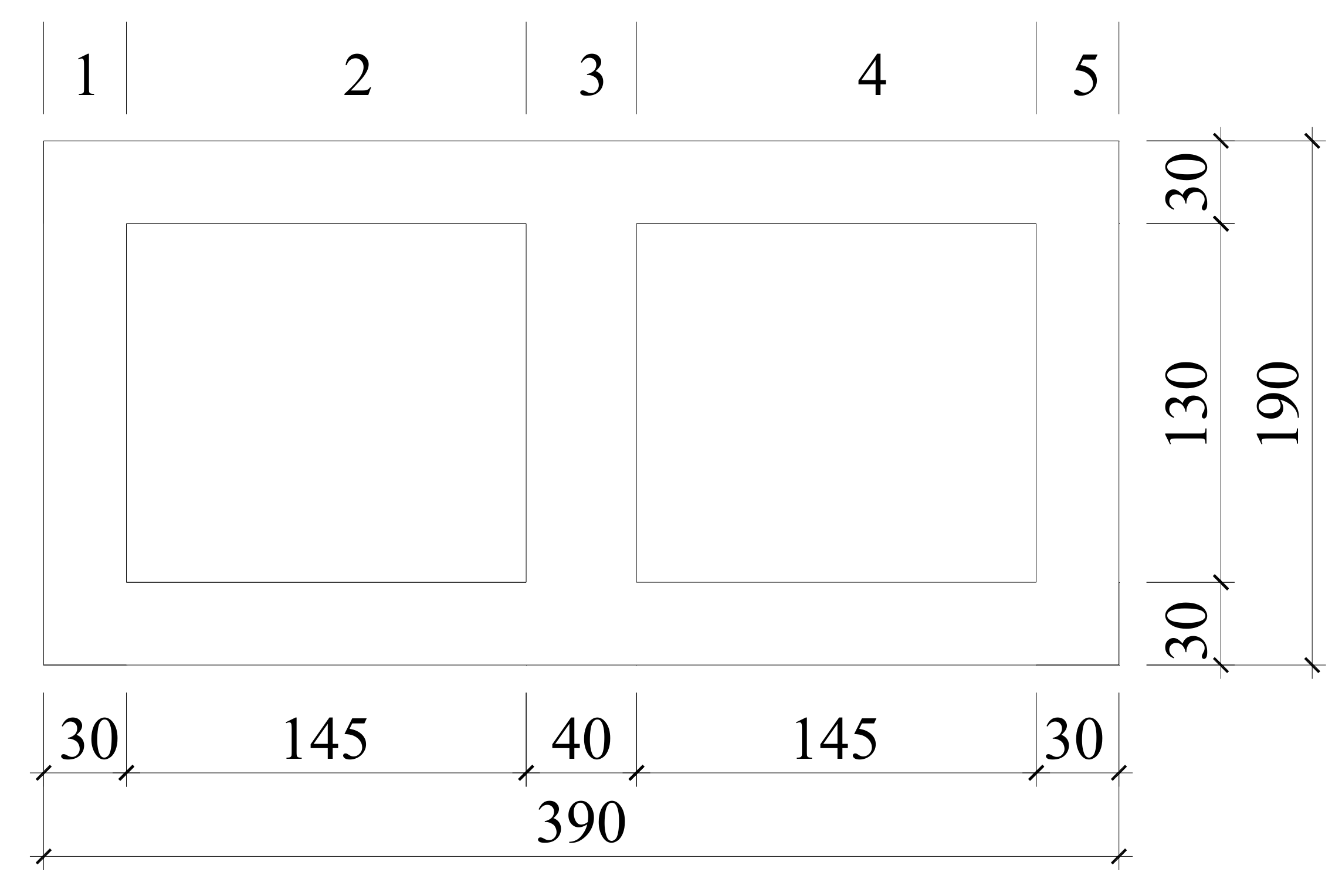
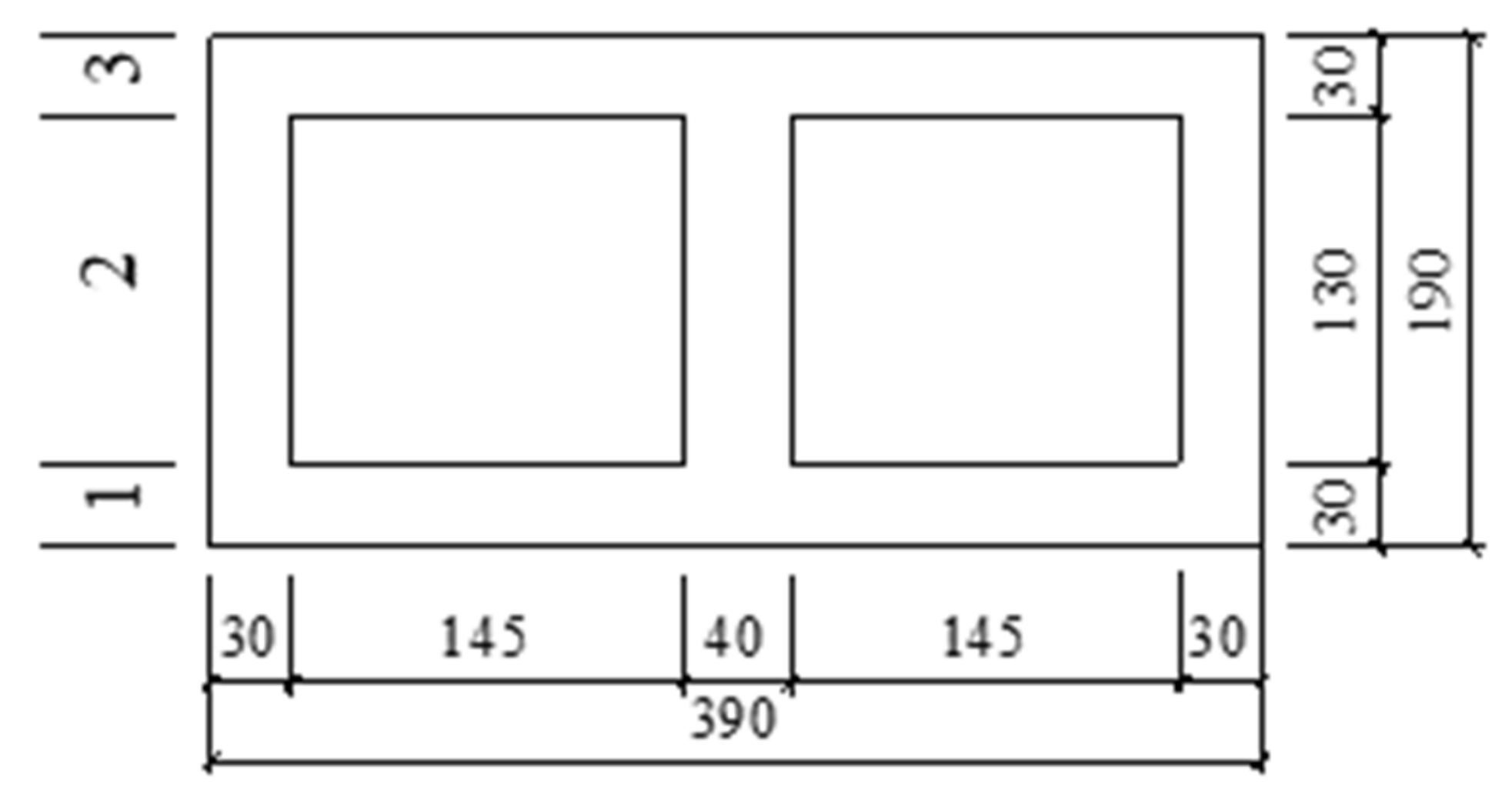
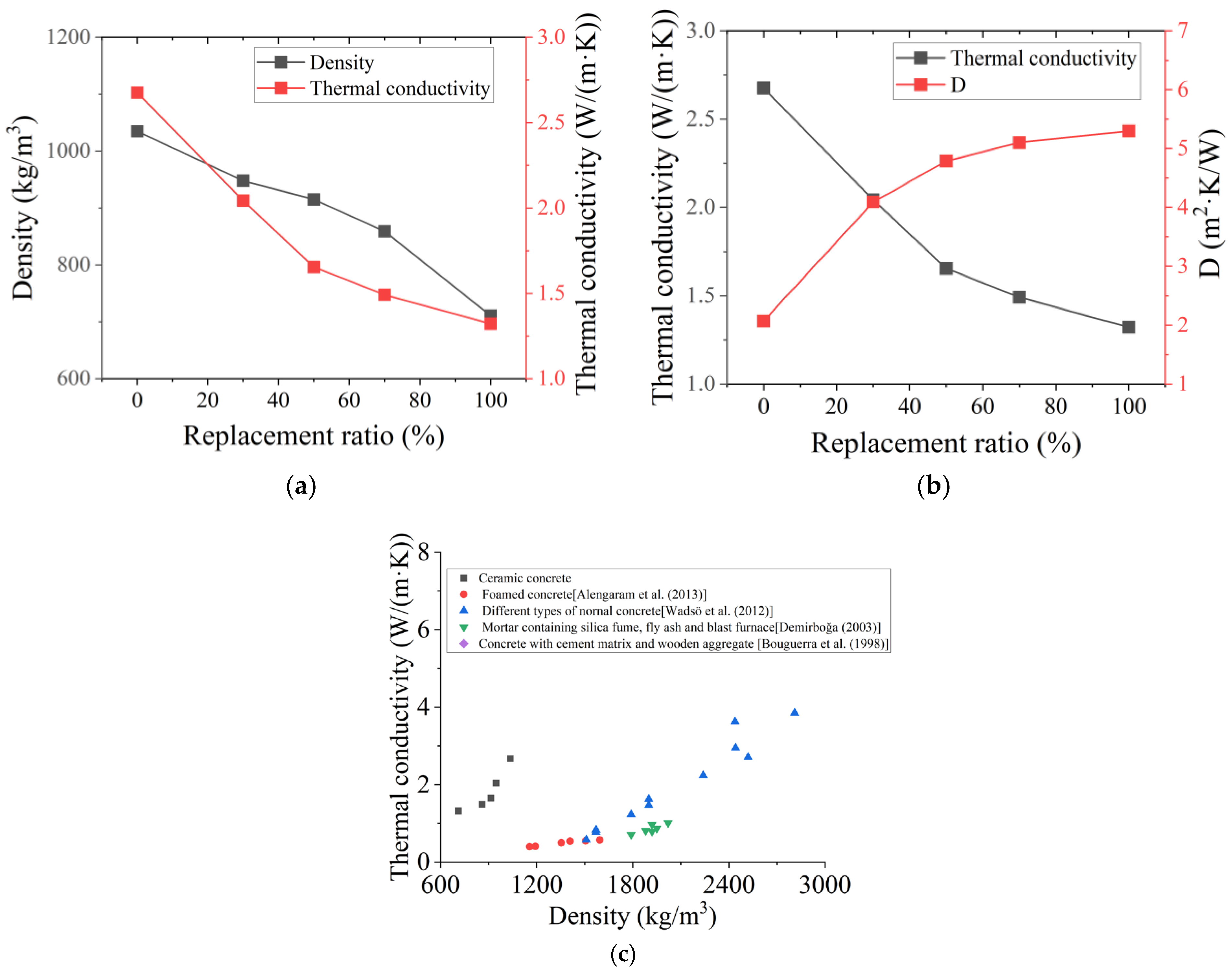
| Gradation/mm | Apparent Density/kg/m3 | Crush Index/MPa | Water Absorption/1 h | Clay Content | Void Ratio |
|---|---|---|---|---|---|
| 5–10 | 1231 | 6.3 | 11.3% | 0.6% | 39% |
| Gradation /mm | Apparent Density /kg/m3 | Crush Index | Water Absorption /1 h | Clay Content | Void Ratio |
|---|---|---|---|---|---|
| 5–10 | 2695 | 8.6% | 0.3% | 0.2% | 32% |
| Gradation /mm | Apparent Density /kg/m3 | Crush Index | Water Absorption /1 h | Clay Content | Fineness Modulus |
|---|---|---|---|---|---|
| 0.16~5 | 2369 | 21% | 5.6% | 1.2% | 2.9 |
| Item | γ/% | W/C | Materials per Volume (kg/m3) | ||||
|---|---|---|---|---|---|---|---|
| Water | Cement | Sand | Ceramic | Aggregate | |||
| RAC0 | 0 | 0.45 | 180 | 400 | 584 | 0 | 845 |
| RAC30 | 30 | 0.45 | 180 | 400 | 614 | 102 | 564 |
| RAC50 | 50 | 0.45 | 180 | 400 | 643 | 170 | 422 |
| RAC70 | 70 | 0.45 | 180 | 400 | 615 | 260 | 276 |
| RAC100 | 100 | 0.45 | 180 | 400 | 760 | 402 | 0 |
| Specimen | Thermal Conductivity (W/(m·K) | Average(W/(m·K) | Thermal Resistance(m2·K/W) | Average (m2·K/W) |
|---|---|---|---|---|
| RC-0-1 | 1.465 | 1.457 | 0.021 | 0.021 |
| RC-0-2 | 1.441 | 0.021 | ||
| RC-0-3 | 1.465 | 0.021 | ||
| RC-30-1 | 0.498 | 0.503 | 0.060 | 0.059 |
| RC-30-2 | 0.512 | 0.058 | ||
| RC-30-3 | 0.501 | 0.059 | ||
| RC-50-1 | 0.308 | 0.301 | 0.098 | 0.100 |
| RC-50-2 | 0.297 | 0.101 | ||
| RC-50-3 | 0.295 | 0.101 | ||
| RC-70-1 | 0.254 | 0.246 | 0.117 | 0.121 |
| RC-70-2 | 0.235 | 0.126 | ||
| RC-70-3 | 0.249 | 0.121 | ||
| RC-100-1 | 0.190 | 0.192 | 0.153 | 0.154 |
| RC-100-2 | 0.194 | 0.155 | ||
| RC-100-3 | 0.192 | 0.154 |
| Item | Channel-1 (m2·K/W) | Channel-2 (m2·K/W) | Channel-3 (m2·K/W) | Channel-4 (m2·K/W) | Channel-5 (m2·K/W) | φ | (m2·K/W) |
|---|---|---|---|---|---|---|---|
| RC-0 | 0.280 | 0.371 | 0.280 | 0.371 | 0.280 | 0.93 | 0.179 |
| RC-30 | 0.528 | 0.449 | 0.528 | 0.449 | 0.528 | 0.93 | 0.295 |
| RC-50 | 0.781 | 0.529 | 0.781 | 0.529 | 0.781 | 0.96 | 0.410 |
| RC-70 | 0.922 | 0.574 | 0.922 | 0.574 | 0.922 | 0.98 | 0.476 |
| RC-100 | 1.140 | 0.643 | 1.140 | 0.643 | 1.140 | 0.98 | 0.562 |
| Item | ||
|---|---|---|
| RC-0 | 0.374 | 2.676 |
| RC-30 | 0.489 | 2.043 |
| RC-50 | 0.604 | 1.654 |
| RC-70 | 0.670 | 1.492 |
| RC-100 | 0.756 | 1.322 |
| Item | |||||||
|---|---|---|---|---|---|---|---|
| Channel-1 | Channel-2 | Channel-3 | Channel-1 | Channel-2 | Channel-3 | ||
| RC-0 | 0.02 | 0.15 | 0.02 | 19.96 | 5.12 | 19.96 | 1.58 |
| RC-30 | 0.06 | 0.39 | 0.06 | 16.48 | 4.23 | 16.48 | 3.60 |
| RC-50 | 0.10 | 0.59 | 0.10 | 12.28 | 3.15 | 12.28 | 4.30 |
| RC-70 | 0.12 | 0.68 | 0.12 | 10.99 | 2.82 | 10.99 | 4.61 |
| RC-100 | 0.16 | 0.82 | 0.16 | 9.23 | 2.37 | 9.23 | 4.81 |
| Item | K | |
|---|---|---|
| RC-0 | 2.676 | 2.07 |
| RC-30 | 2.043 | 4.09 |
| RC-50 | 1.654 | 4.79 |
| RC-70 | 1.492 | 5.10 |
| RC-100 | 1.322 | 5.30 |
Disclaimer/Publisher’s Note: The statements, opinions and data contained in all publications are solely those of the individual author(s) and contributor(s) and not of MDPI and/or the editor(s). MDPI and/or the editor(s) disclaim responsibility for any injury to people or property resulting from any ideas, methods, instructions or products referred to in the content. |
© 2023 by the authors. Licensee MDPI, Basel, Switzerland. This article is an open access article distributed under the terms and conditions of the Creative Commons Attribution (CC BY) license (https://creativecommons.org/licenses/by/4.0/).
Share and Cite
Wang, Y.; Wang, J.; Deng, Z.; Xiao, J. Studying Thermal and Mechanical Properties of Recycled Concrete by Using Ceramic Aggregate. Sustainability 2023, 15, 2642. https://doi.org/10.3390/su15032642
Wang Y, Wang J, Deng Z, Xiao J. Studying Thermal and Mechanical Properties of Recycled Concrete by Using Ceramic Aggregate. Sustainability. 2023; 15(3):2642. https://doi.org/10.3390/su15032642
Chicago/Turabian StyleWang, Yumei, Jinyan Wang, Zhiheng Deng, and Jianzhuang Xiao. 2023. "Studying Thermal and Mechanical Properties of Recycled Concrete by Using Ceramic Aggregate" Sustainability 15, no. 3: 2642. https://doi.org/10.3390/su15032642






